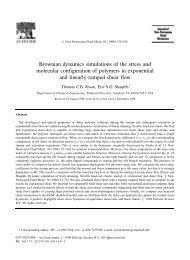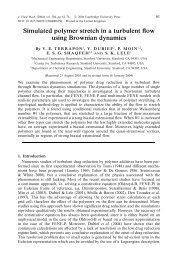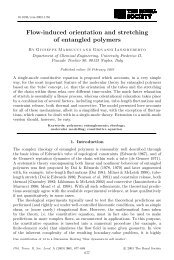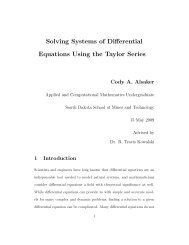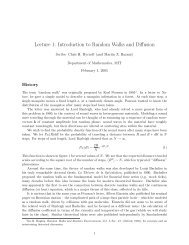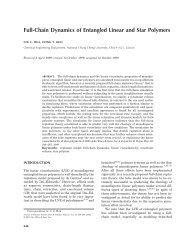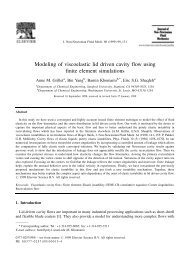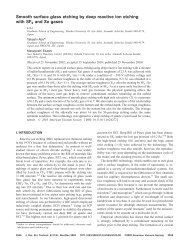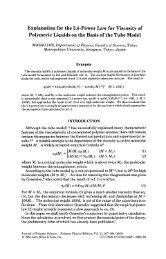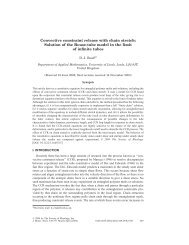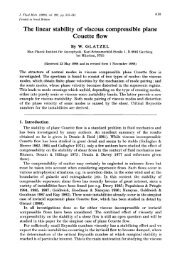A numerical study of the rheological properties of suspensions of ...
A numerical study of the rheological properties of suspensions of ...
A numerical study of the rheological properties of suspensions of ...
Create successful ePaper yourself
Turn your PDF publications into a flip-book with our unique Google optimized e-Paper software.
184reduced integral relationM. B. Mackaplow and E. S. G. ShaqfehNoting thatand, similarlylirntd'(5, lk - p) + -4jl(lk .p)(A 14)limt,oF(lk -p, 5) + -5jl(lk .p)(A 15)we can substitute our integral expression for Ql(5, 5) into <strong>the</strong> definition <strong>of</strong> pfibre andusing <strong>the</strong> limits defined above, we obtainp fibre - 4npn133 In( 2A)2n13p21 f dkj:(lk .p)pkG;,pl(k)n In( 2A)where <strong>the</strong> first term on <strong>the</strong> right-hand side is <strong>the</strong> one-particle result and <strong>the</strong> secondterm is <strong>the</strong> correction due to two-particle interactions. Note that this methodrigorously takes into account all first reflection interactions on <strong>the</strong> value <strong>of</strong> pfibre.These give <strong>the</strong> leading order correction in <strong>the</strong> dual limit n13 + 0 and A + 1 (ormore precisely, l/ln(2A) 4 1). To complete <strong>the</strong> derivation we need only determinepkGLipl(k). If we examine <strong>the</strong> Green's function calculated by Shaqfeh & Fredrickson(1990) for aligned fibre <strong>suspensions</strong>, <strong>the</strong>n it can be shown that4 ~ F(kx, ~ 1 kx)( 1 - x ~ + ) 2H(kx, ~ kx)x2( 1 - x2)(A 17)PkG;ipdk) nln(2A) p2k4where x = lk - p .manipulating givesSubstituting this result back into <strong>the</strong> integral for pfibre and[l- ji(kx)]j;(kx)(l - x2)2 2jt(kx)[l - j;(kx) - 3j?(kx)]x2(1 - x2)J = lmdklldxk2k2(A 19)The integral J was completed <strong>numerical</strong>ly and found to have <strong>the</strong> value J = 0.01718.2-bodyWith this <strong>numerical</strong> result we obtain <strong>the</strong> quoted value <strong>of</strong> QAiigned found in $4.2.A.3. Isotropic <strong>suspensions</strong>Interestingly <strong>the</strong> equation for pfibre derived above in terms <strong>of</strong> G;, remains <strong>the</strong> sameif <strong>the</strong> suspension is isotropic, but, <strong>of</strong> course, <strong>the</strong> value <strong>of</strong> G;, changes. This equationphysically represents <strong>the</strong> fact that <strong>the</strong> dipole or stresslet correction on a given fibreoccurs due to <strong>the</strong> average reflected field from <strong>the</strong> surrounding fibres. Thus, <strong>the</strong>method <strong>of</strong> calculating this change does not depend on <strong>the</strong> orientation distribution,but <strong>the</strong> form <strong>of</strong> <strong>the</strong> reflected field does.Turning <strong>the</strong>n to <strong>the</strong> calculation <strong>of</strong> G;, for isotropic <strong>suspensions</strong>, we have that <strong>the</strong>self-energy no longer depends on any preferred direction, and takes <strong>the</strong> form+



